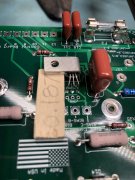J!m
Veteran and General Yakker
But the Teflon is not very flexible.
I agree it is about as good as "wire" gets, and that's why it's used in aircraft. Insulation will not chafe on itself in bundles, because it's so slippery. They should have used that in BMW E36 trunk wiring harnesses, to avoid all those fires...
I agree it is about as good as "wire" gets, and that's why it's used in aircraft. Insulation will not chafe on itself in bundles, because it's so slippery. They should have used that in BMW E36 trunk wiring harnesses, to avoid all those fires...

